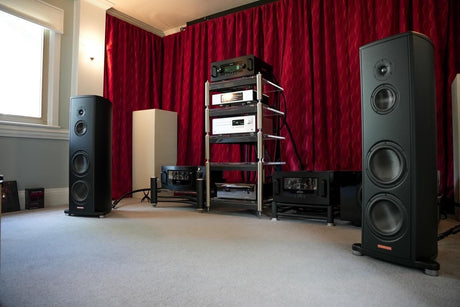
Serious Fun at Big Kids Toys
In the March 2025 installment of Stereophile’s excellent “Re-Tales” column, author Julie Mullins highlights Big Kids Toys — an AudioQuest Mythical Experience dealer — and speaks with its 29-year-old sales...
Câble d'interconnexion audio
Souvent, le choix entre terminer vos câbles d'enceinte avec des fourches ou des fiches bananes dépendra de la préférence personnelle. Cependant, les bornes de liaison isolées conformes à l'UE utilisées sur certains amplificateurs de puissance rendent souvent difficile, voire impossible, de serrer les fourches avec un couple ou une pression élevés. Dans ces applications, le connecteur banane AudioQuest est le choix supérieur, et peut être le seul choix.
AudioQuest a mené une enquête assez exhaustive auprès des fabricants d'amplificateurs contemporains pour déterminer si les fourches ou les bananes seront les plus appropriées pour une marque et un modèle d'amplificateur donnés. Veuillez nous contacter, fournir la marque et le modèle de l'amplificateur, et nous répondrons avec le type de connecteur optimal.
Ici, nous recommandons généralement le connecteur U-Spade ou banane. Cependant, même s'il y a moins de poids et de pression de ce côté du câble (particulièrement pour les ensembles BiWire), il est néanmoins important de noter la conception du bornier. Si un connecteur banane ne peut pas s'insérer complètement dans la bornier, nous recommandons l'un de nos connecteurs à fourche.
Conducteurs en cuivre à surface parfaite solide+ (PSC+)
Les conducteurs solides empêchent l'interaction électrique et magnétique des brins. Le cuivre solide PSC+ minimise la distorsion causée par les frontières de grains et maximise la dissipation linéaire du bruit RF.
Dissipation de bruit à 3 couches basée sur Carbon
Il est facile d'obtenir une couverture de blindage à 100%. Empêcher les interférences radiofréquences (RFI) capturées de moduler la référence de masse de l'équipement nécessite le Noise-Dissipation System (NDS) d'AQ. Les systèmes de blindage traditionnels absorbent généralement et drainent ensuite l'énergie bruit/RF vers la masse du composant, modulant et déformant le plan de masse « de référence » critique, ce qui entraîne à son tour une distorsion du signal. Les couches alternées de métal et de synthétiques chargés de carbon du NDS « protègent le blindage », absorbant et réfléchissant la plupart de cette énergie bruit/RF avant qu'elle n'atteigne la couche attachée à la masse.
Système de polarisation diélectrique 72v (DBS)
Toute isolation entre deux ou plusieurs conducteurs est également un diélectrique dont les propriétés affecteront l'intégrité du signal. Lorsque le diélectrique n'est pas polarisé, l'implication diélectrique (absorption et libération non linéaire d'énergie) provoque différents délais (décalage de phase) pour différentes fréquences et niveaux d'énergie, ce qui est un réel problème pour l'audio multi-octave très sensible au temps. L'inclusion d'un piège RF (développé pour la série de produits d'alimentation AudioQuest de Niagara), garantit que le bruit radiofréquence ne sera pas induit dans les conducteurs de signal par les éléments de champ DBS. (DBS, US Pat #s 7,126,055 & 7,872,195 B1)
Les conducteurs positifs bénéficient de presque aucun contact entre le métal et son isolation FEP, qui est remarquable pour sa constante diélectrique supérieure et son interférence de signal minimale. Les conducteurs négatifs bénéficient d'une « isolation délibérément perdante » — pas d'air et pas de FEP aide à maximiser le rôle différent de la connexion négative.
Géométrie double équilibrée asymétrique
Conçu spécialement pour les applications à terminaison simple, la géométrie double équilibrée asymétrique offre une impédance relativement plus faible sur la masse pour une expérience plus riche et plus dynamique. Alors que de nombreux câbles à terminaison simple utilisent un seul chemin pour la masse et le blindage, les conceptions double équilibrée séparent les deux pour une performance plus propre et plus silencieuse.
Terminaisons en cuivre rouge pur plaqué argent direct soudé à froid
Le placage argent direct est optimisé pour le son, sans couche sous-jacente de nickel causant des distorsions, tandis que le processus de soudage à froid hautement efficace évite la dégradation sonore par la soudure.